#henriette marie de france
Explore tagged Tumblr posts
Text
0 notes
Note
The mesdames calling madame de pompadour "maman-putain" is so funny to me. Do you have more random funny shot that they (including their brother) did.
Oh anon I was made for this
Dauphin called Madame de Pompadour I belieave "Madame Pompom"
Adelaide, when she was like 9 to 11, escaped to go "bring back the head of the English king like Judith and Holofernes", I believe she got as far as the stables, where a stablehand had a donkey waiting for her. The book I read this from, I can't remember it's name, said "That's the spirit! Here is a heroine with whom the Judith of Bethulia is only a pale moonlight." and honestly I love it
When Dauphin was a child one of his younger sisters- probably Adelaide given the fact that she was one of the few that he saw as a child -slipped a curse word and he gave her such a bad reprimand that she never forgot it and she started crying
Henriette, Adelaide, and Dauphin's wife, Marie Therese Raphaelle, had a little network trying to get rid of Madame de Pompadour, they were *so* into it, Henriette was the first to call her Maman Putain, and Adelaide and Raphaelle devoted themselves to intel. Adelaide was very young at the time and I imagine that was her first foray into politics
One of Adelaide's governesses when she was a teenager accidentally gave her erotica, although this might be false
When Adelaide and Victoire were on their last leg, living in Naples, they had a concert from the governer of the Count of Chastellux, who played the violin (shittily). It was so bad that Adelaide, who was a violinist so good that even the misogynistic men of the French court (Violin was considered a masculine instrument at the time) admitted she was good, took the violin, playing music. Unfortunately, despite the fun that Adelaide was having- which she sorely needed honestly considering this was after the French Revolution -Duchesse de Narbonne gave her a harsh rebuke because she was a Princess. Apparently, an artist named Goubaud, who I believe is Innocent-Louis Goubaud sketched the scene, but I don't believe we have it anymore.
After Louise went to her convent, Madame Campan, Victoire's lady in waiting, asked if Victoire would ever go to a convent. Victoire assured her that she wouldn't, and said, "Here’s the armchair that ruins me", pointing to the chair she was laying in.
Adelaide was called Madame Torchon by her family and friends, even her older sister Louise Elisabeth called her that in a letter. She called herself it in a letter to the Countesse de Civrac, who I believe at the time was Anne-Marie de La Faurie de Monbadan
If I have more I'll add them!
#aight time to tag#asks#mesdames de france#louis ferdinand of france#louis dauphin of france#dauphin louis of france#madame adelaide#madame de pompadour#anne henriette of france#marie therese raphaelle of spain#María Teresa Rafaela of Spain#louise elisabeth of france#princesses of france#dauphins of france
6 notes
·
View notes
Text
29 gennaio … ricordiamo …
29 gennaio … ricordiamo … #semprevivineiricordi #nomidaricordare #personaggiimportanti #perfettamentechic
2023: Annie Wersching, attrice statunitense. Attiva prevalentemente in televisione, è nota per aver interpretato Amelia Joffe nella soap opera General Hospital, Renee Walker nella serie 24, Lily Salvatore nella serie The Vampire Diaries e la Regina Borg nella serie Star Trek: Picard. Ha iniziato l’attività di attrice nel 2002. Wersching ha sposato l’attore comico Stephen Full nel 2009. La coppia…

View On WordPress
#29 gennaio#Alan Ladd#Alan Walbridge Ladd Jr#Annie Wersching#Enrico Olivieri#Frances Goodrich#George R. Robertson#George Ross Robertson#Helen Darling#Helen Talbot#Howard Hesseman#Jean-Pierre Aumont#Jean-Pierre Philippe Salomons#Leif Erickson#Marie-Laure de Noailles#Marie-Laure Henriette Anne Bischoffsheim#Nazareno Fonticoli#Ricordiamo#Robert Frost#Sara Teasdale#Thelma Furness#Thelma Morgan#Ugo Bologna#Vicomtesse de Noailles#viscontessa Furness#William Wycliffe Anderson
1 note
·
View note
Text
For this 2nd day of Pride Month I decided to talk about a woman I mentionned yesterday in the post about Renée Vivien (that you should absolutely read by the way, Renée Vivien is amazing) :
Natalie Clifford Barney !
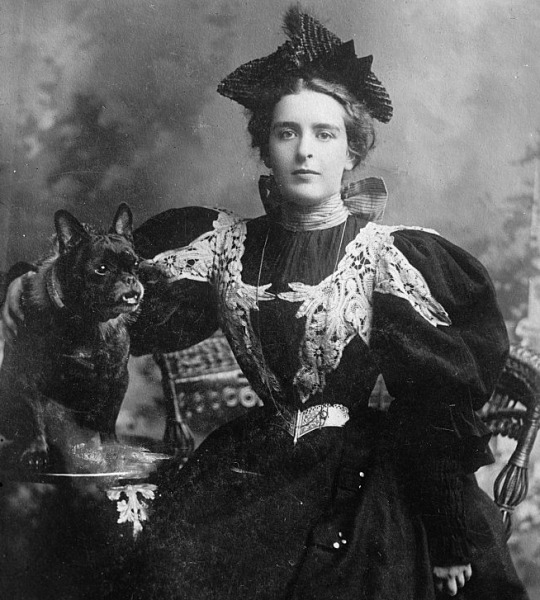
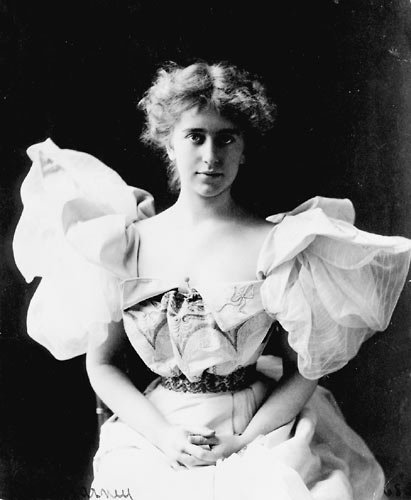
I talked about her to say that she's had a love story with Renée Vivien, but that's not the only thing she's done.
Natalie was born in 1876 in the United States and died in 1972 in Paris, at the age of 95. Writer and poet, she was the first woman to use the word "lesbian" in her writings (in this case a collection of poems, published in 1899), instead of the word "tribade" (it's another word for lesbian in french) or simply "homosexual". The word lesbian back then was even more taboo than it is today, so you can imagine how important this fact was (and still is).
She was also famous for the parties she organised: she held a literary salon which she wanted to turn into the "new Mytilene". She invited the female artists, writers and intellectuals of her time, in response to the all-male Académie Française, and they all spent whole afternoons and evenings in the flat of the wealthy American.
Natalie never tried to hide her homosexuality. As she said in a sentence that quickly became her most famous one,
"Why would anyone blame me for being a lesbian ?"
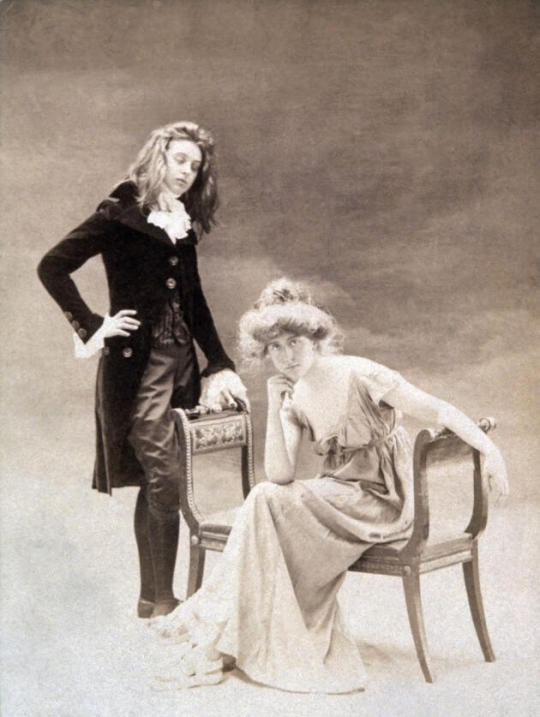
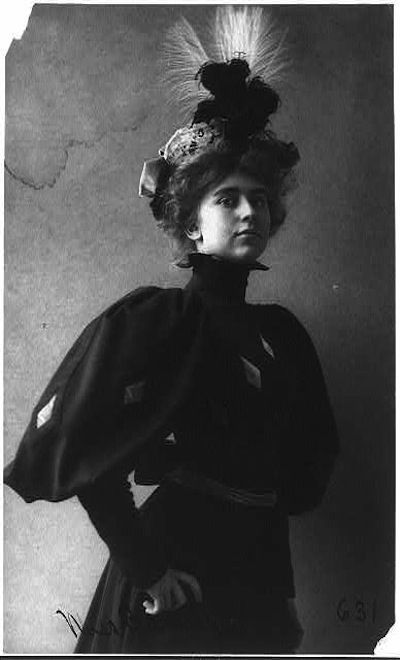
(Yes, that's her with Renée Vivien)
Natalie's mother (a renowned artist) and her tutor awakened her interest in the French language at an early age, and when she was a little older, she was sent to a school in France; thanks to this, she spoke French fluently and without an accent, and developed a soft spot for this country.
Natalie was 12 when she realized she was a lesbian, and decided right away to "live in the open, without hiding from anyone".
Hee first known relationship was with Liane de Pougy, a famous dancer of the time (whom she cheated on with many women). Natalie wrote about this love story in her collection Quelques portraits, sonnets de femmes. ("Some portraits, sonnets of women"). Liane wrote about it in her novel "Idylle sapphique", which so fascinated the French public that it had to be reprinted sixty times in the same year, with people torn between admiration and scandal. The two women eventually parted ways, however, due to Natalie's infidelities and Liane's "debauched lifestyle" (in Natalie's words).
As I said, this book caused a huge scandal. Natalie was forced to return to the United States, where her father burned all her writings he could find, and tried to marry her off. However, she categorically refused to obey him, and faced with her stubbornness, her father gave up, and Natalie returned to Paris, where she had a lot of lovers. Among these lovers, there's Renée Vivien (probably the most important, since Natalie never accepted their breakup and tried to get Renée back until Renée died at 32) Lucie Delarue-Mardrus, Colette, Emma Calvé, Olive Custance, Henriette Roggers and many others.
In 1902, on the death of her father, Natalie Clifford Barney inherited a large fortune and was able to rent a house in Neuilly-sur-Seine, where she gave parties that became the talk of the town.
In 1910, she moved into a house at 20 rue Jacob ; for nearly sixty years, this house was the setting for her famous "Fridays", one of the last influential literary salons. A LOT of famous people went there. Like really. The complete list is on Wikipedia if you're curious, and here's a screenshot with some examples :
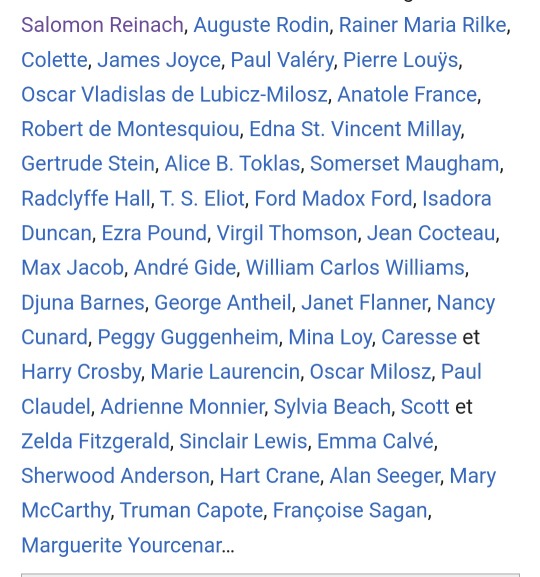
Marie Skłodowska-Curie went there. Albert Einstein went there. Apollinaire and Proust went there. Oscar Wilde went there. That's cazy to me!
She's had other lovers, like Elisabeth de Clermont-Tonnerre, but her greatest love story was with the painter Romaine Brooks, with whom she had a relationship similar to that of a married couple from 1914 to the end of her life. Of course, this didn't stop her from cheating on Romaine with other women: Natalie was known for her infidelities, believing that polygamy was necessary for a couple's survival, although she claimed that this didn't stop her from being deeply in love with Romaine. She cheated on her for example with Oscar Wilde's niece Dolly, and Nadine Huong, whose story I'll tell one day because it's so interesting!
She spent the years of the Second World War in Italy, and later returned to France to find her second home, which she shared with Romaine Brooks, destroyed. In 1949, she reopened her salon (which started to welcome more and more famous actors and actresses on top on everyone else).
Nothing much happened for the rest of his life. She never left Romaine Brooks (despite continuing to have affairs with a host of other women) and died in Paris in 1972, aged 95.
Natalie Clifford Barney's work and life were very important not only for culture itself, but also for the lesbian community. She made a major contribution to lesbian visibility, opened many minds, helped normalize (even if we still have a long way to go) homosexuality and, above all, helped many lesbian women accept themselves, understand that they were not alone and live the life they deserved.
The influence of her works and her salon on culture, literature, cinema, theater and even science is immense and deserves to be recognized. We should be talking about her much more than we are!
Here's some of her poems with an english translation :
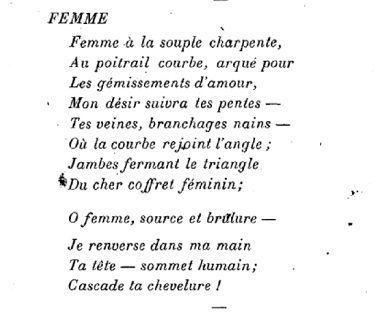
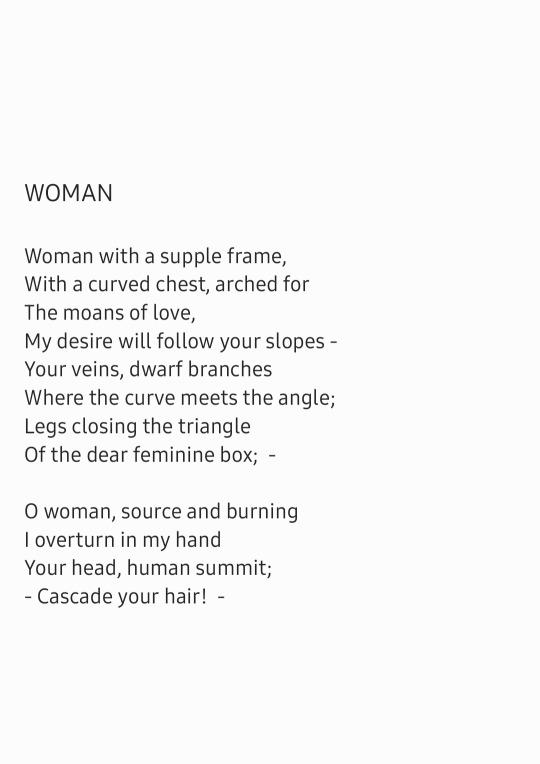
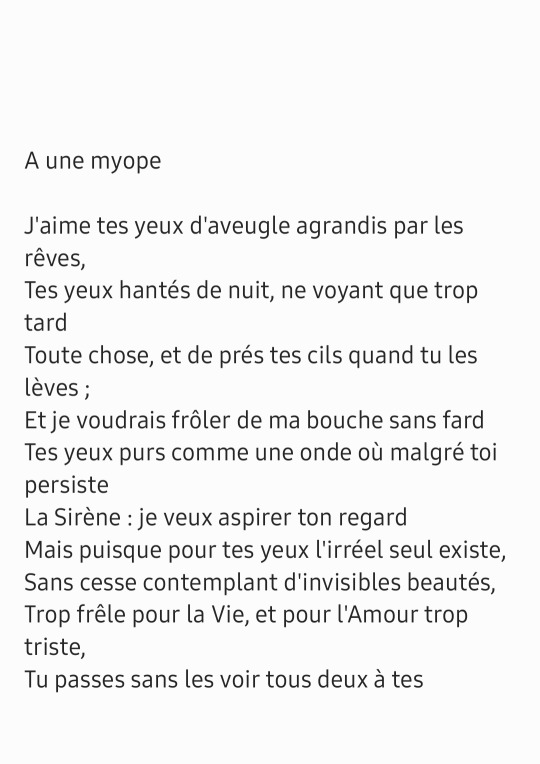
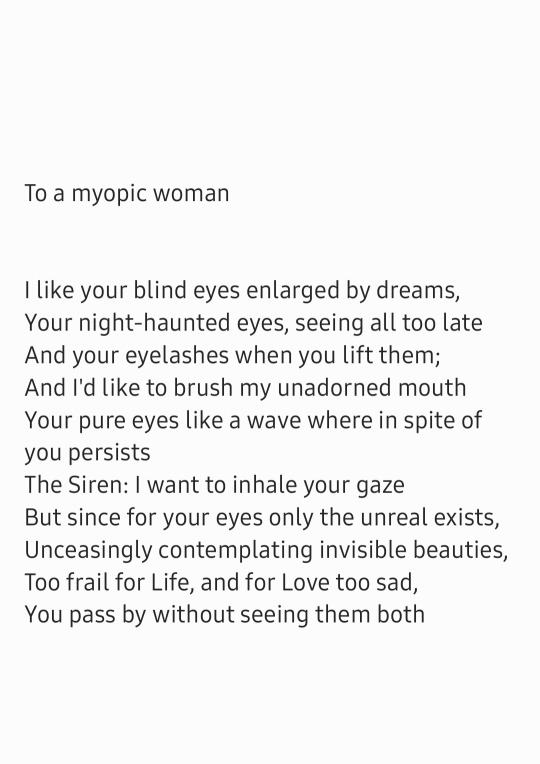
And she's written loads of other stuff that I really recommend you read! She was an interesting woman who wrote interesting things. Look her up on Google and read her writings and her life!
Anyway, that's it! Sorry for posting so late, and see you tomorrow for the 3rd lesbian pride post 🏳️🌈
#lesbian#lesbian pride#pride#pride month#lgb#lgbt history#lgbt#female homosexual#female homosexuality#female history#women's history#herstory#lesbian history#poetry#french poetry#po��sie française#poésie#american writer#natalie clifford barney
134 notes
·
View notes
Text
Litany of American Saints
(Updated 2024)
In the Name of the Father, and of the Son, and of the Holy Spirit, Amen.
Lord, have mercy on us. Christ, have mercy on us. Lord, have mercy on us. Christ, hear us.
God, the Father of heaven, have mercy on us. God the Son, Redeemer of the world, have mercy on us. God the Holy Spirit, have mercy on us. Holy Trinity, one God, have mercy on us.
Our Lady of Guadalupe, pray for us.
Saint Isaac Jogues, pray for us. Saint René Goupil, pray for us. Saint Jean de Lalande, pray for us. All you holy North American Martyrs, pray for us.
Saint Frances Xavier Cabrini, pray for us. Saint Elizabeth Ann Seton, pray for us. Saint John Neumann, pray for us. Saint Rose Philippine Duchesne, pray for us. Saint Katharine Drexel, pray for us. Saint Mother Théodore Guérin, pray for us. Saint Damien de Veuster of Molokai, pray for us. Saint Marianne Cope of Molokai, pray for us. Saint Kateri Tekakwitha, pray for us. Saint Junípero Serra, pray for us.
Blessed Eduardo Farre, pray for us. Blessed Carlos Manuel Rodriguez, pray for us. Blessed Diego Luis de San Vitores, pray for us. Blessed Francis Xavier Seelos, pray for us. Blessed Lucas Tristany, pray for us. Blessed Carlos Manuel Rodriguez Santiago, pray for us. Blessed Michael McGivney, pray for us. Blessed Sister Miriam Teresa, pray for us. Blessed Stanley Rother, pray for us. Blessed Solanus Casey, pray for us. Blessed Leo William Miller, pray for us.
Venerable Antonio of Jesus, pray for us. Venerable Nelson Baker, pray for us. Venerable Frederic Baraga, pray for us. Venerable Cornelia Connelly, pray for us. Venerable Henriette DeLille, pray for us. Venerable Teresa Demjanovich, pray for us. Venerable Maria Kaupas, pray for us. Venerable Mary Theresa Dudzik, pray for us. Venerable Samuel Charles Mazzuchelli, pray for us. Venerable Mary Angeline Teresa McCrory, pray for us. Venerable Fulton J. Sheen, pray for us. Venerable Pierre Toussaint, pray for us. Venerable Félix Varela, pray for us. Venerable Augustus Tolton, pray for us. Venerable Rafael Cordero Molina, pray for us. Venerable Aloysius Schwarz, pray for us. Venerable Alphonse Gallegos, pray for us. Venerable Patrick Peyton, pray for us. Venerable Norbert McAuliffe, pray for us. Venerable Eusebio Kino, pray for us. Venerable Mary Elizabeth Lange, pray for us. Venerable Rose Hawthorne, pray for us.
Lord, be merciful. Lord, save your people. From all evil, Lord, save your people. From all sin, Lord, save your people. From your wrath, Lord, save your people. From injustice, Lord, save your people. From oppression, Lord, save your people. From hatred and intolerance, Lord, save your people. From anger and ill-will, Lord, save your people. From violence and bloodshed, Lord, save your people. From indifference to suffering, Lord, save your people.�� From all the snares of the devil, Lord, save your people. By the mystery of your holy Incarnation, Lord, save your people. By your Coming, Lord, save your people. By your Birth, Lord, save your people. By your Baptism and holy fasting, Lord, save your people. By your Cross and Passion, Lord, save your people. By your Death and Burial, Lord save your people. By your holy Resurrection, Lord, save your people. By your wonderful Ascension, Lord, save your people. By the coming of the Holy Spirit, Lord, save your people. On the day of judgment, Lord, save your people.
Be merciful to us sinners, Lord, hear our prayer. That you will spare us, Lord, hear our prayer. That you will pardon us, Lord, hear our prayer. That it may please you to bring us to true penance, Lord, hear our prayer. Guide and protect your Holy Church, Lord, hear our prayer. Preserve in holiness the Pope and all the clergy, Lord, hear our prayer. Humble the enemies of the Church, Lord, hear our prayer. Give peace and unity to the whole Christian people, Lord, hear our prayer. Guide all those who serve us in civil government, Lord, hear our prayer. Protect all those who serve in our armed forces, Lord, hear our prayer. Grant eternal rest to all those who have died in defense of liberty, Lord, hear our prayer. Give courage to those who stand for justice, Lord, hear our prayer. Strengthen and preserve us in your holy service, Lord, hear our prayer. Deliver our souls from eternal damnation, Lord, hear our prayer. Grant eternal rest to all the faithful departed, Lord, hear our prayer. That it may please you to hear and heed us, Jesus, Son of the Living God, Lord, hear our prayer.
Lamb of God, who takes away the sins of the world, spare us, O Lord! Lamb of God, who takes away the sins of the world, graciously hear us, O Lord! Lamb of God, who takes away the sins of the world, have mercy on us.
Christ, hear us. Lord Jesus, hear our prayer. Lord, have mercy on us. Christ, have mercy on us. Lord, have mercy on us.
In the Name of the Father, and of the Son, and of the Holy Spirit, Amen.
24 notes
·
View notes
Text
Assassin's Creed Syndicate - Sanctity: Doña Aimée Isabelle Henriette Artois-Cotoner, La Condesa de Tortosa.
_______________________________________________


_______________________________________________
-Portrait of Lady Aimée Artois, 1860.-
Aimée Isabelle Henriette Cotoner (Née Artois) was a French Philantropist, Socialite, Musician and Fashion Icon of the Spanish and French Courts in the 19th Century.
.
The youngest daughter of Frederic Alphonse D'Artois , Comte d'Eu and his wife, Marie Johanna von Lamberg. Being the granddaughter of Charles Ferdinand D'Artois, Duke of Berry and great-granddaughter of Charles X of France.
.
Born in 1830, the very year of the July Monarchy and the incredibly political tension in her country and her family. Aimée, despite being descendent of an Absolutist Monarchy Family, had her father and mother being much more alliegned with a Constitutional Monarchy, which made them eventually become allies to the French and Austrian Brotherhoods of Assassins.
.
Born and raised in Eu, Normandy. She was kept away from the chaos of the court most of her life. Receiving the best education her father could provide, she grew up to be a refined, eloquent and clever young woman. A lover of the arts and it's many forms.
.
Although her family's political connections to the Brotherhood, Aimée never showed interest in taking part in such business. Fearing what the connection between this other secret society could bring to her loved ones (Her family already have once being alliegned to the French Rite of the Templar Order), her worries would triple as her older sister, Félicité, married a Master Assassin of the Dutch Brotherhood and becamed an active ally to their cause.
.
She herself would dwell more into this world after being married to Carlos Rafael Cotoner y Moncada, Conde de Tortosa. Despite being arranged, love bloomed among the couple, that would go on and have five children, even if only two were born.
.
As the wife and mother of Spanish Master Assassins, her role in the Creed would fortify. The years spent among the Tenents would make her shape her world views to one closer to the Assassins, however, she never truly accepted or approved her husband and daughter's role in this. For she always lived afraid of loosing them in this secret war.
.
A loving mother, a caring wife, a noblewoman of the House of Bourbon, descendent of the very Capetian Dynasty, proud of her family and legacy... A woman who left her mark on history for her donations to charities and her work in the development of arts and music.
Hélix Data Base / Entry of the Countess of Tortosa
Art by @gabmik
#assassin's creed#assassin's creed: syndicate#assassin's creed oc#assassin's creed syndicate oc#my oc#Aimée Artois#Countess Aimée Isabelle Henriette Artois-Cotoner#Condesa de Tortosa#AC D'Artois Family#AC Cotoner Family#French Noblewoman OC#Victorian Era#French Dove 🕊️🤍#Friend's art#My AC OC#Friend's gift#Solange and Serena's mother#Desirée's younger sister#Carlos' wife#My beloved french lady <3#Go check Mika out everyone!!!#GO GIVE HER ART ALL THE LOVE SHE DESERVES 🫵🏽🫵🏽🫵🏽#Character Aesthetic#Aimée Aesthetic#OC database#fan helix datase#Assassin's Creed Sanctity#assassin's creed fanfiction#Assassin's Creeed fanfic#My AU
10 notes
·
View notes
Text
Turn Week 2024: Day 2 - Switch Sides!
A bit of alternative history today! I was really intrigued by the “Switch Sides” prompt – but since I only have any sort of knowledge about La Fayette, I would have to make La Fayette switch sides. I feel like there are more reasonable scenarios for George Washingtons and the likes switching sides, then there are for La Fayette.
But here is my interpretation of one scenario that is still unlikely but also less unlikely than other scenarios. And it all has to do with this guy right here: Emmanuel Marie Louis de Noailles.

The year is 1778. In February of this year, La Fayette had just recovered from being wounded during the Battle of Brandywine on September 11, 1777. The Surrender of Saratoga on October 17, 1777 was a great victory for the Continental Army but otherwise things look rather harsh. It is in February 1778 that La Fayette realises that the planned invasion of Canada is not feasible and there is a lot of infighting between the high-ranking officers in the army. He himself later confides in a letter to Washington that he suspects he was only chosen for the campaign in Canada in order to separate him from Washington and to weaken the commander-in-chief position. La Fayette reassumes command of his division at Valley Forge. Now, you can argue that the army survived worse winter encampments then Valley Forge but even so, the situation in Valley Forge was less then ideal. It was also around this time, early 1778, that news of the Franco-American Alliance reached La Fayette’s ears as well as the news that his oldest daughter Henriette had died in late 1777.
We know that La Fayette asked Congress in October of 1778 for a leave of absence to return to France, but we also know from letters between him and his wife Adrienne that he had been thinking about returning to France earlier then he did in the end.
So let us assume that La Fayette returned to France around March of 1778. Once home in France, he meets his wife and family again, he sees his daughter Anastasia for the first time and can visit the grave of Henriette. Maybe Adrienne begs him not to return to America. She is in the early stages of her pregnancy with Georges (earlier now then in reality since La Fayette also returned earlier) and does not want to go through all this while her husband and the child’s father is an ocean away. Brandywine as in the end just a slap on the wrist but it could have gone so much worse for La Fayette – so many of his ancestors had died young and left widows and orphans behind, surely he does not wish this fate to befall his own family. Henriette died while he is away and he had no change to be with her, no change to mourn with his family, he was not even aware of his daughter’s death for several months – could he forgive himself, if he returned to America and Anastasie died, or Adrienne while giving birth, or the new baby? Could he forgive himself if he chose America over his family?
But La Fayette burns with a passion and sitting on the bench is just not something he has the patience for. Therefor, his father-in-law, the duc d’Ayen, approaches him with an idea. The French ambassador to the English court is the ducs brother, Emmanuel Marie Louis de Noailles, and La Fayette had already visited him on his post in February and March 1777. He really had liked his stay in London, we know that from his letters and London like him. In this version La Fayette would arrive right at the tail-end of Noailles turn as ambassador. His mission ended on March 17, 1778 when he informed King George III of the Franco-American alliance. So since we are already deep in the territory of alternative history, let us assume that some aspects move a bit slower or faster time wise and La Fayette has maybe two or three weeks with Noailles in London. La Fayette likes London and London generally likes him. At firsts La Fayette thinks he is merely using the British, using the exiting charm he presents to the high society – and he does – to an extent. But he has also seen the horrors of war. He has seen people suffer and die, he has seen his friends suffer and die – he himself suffered. He has seen the disarray of the army, the infighting, the insufficient funds, the squabbling of Congress, the losses and defeats and not even the intervention of France has brought a sudden and magical change. He maybe even has some candid discussions about the matter of slavery.
And maybe throughout all of this, La Fayette realises that peace is a fine thing – even an imperfect peace. Yes, America might obtain her complete independence, one day, but at what cost? Now that he has spend time with his uncle-in-law in London and perhaps even after Noailles is recalled, some of the British proposals seem almost acceptable. Maybe negotiating for peace is the help he can render America?
Anyway, I like polls and I am curious - do you think that there is a scenario, any scenario, where La Fayette would become more pro-British, not even completely switching sides but simply changing his point of view?
#turn week 2024#turn week#alternate history#marquis de lafayette#french history#la fayette#american history#history#american revolution#lafayette#polls#1777#1778
11 notes
·
View notes
Text
Collaborative Masterpost on Saint-Just
Primary Sources
Oeuvres complètes available online: Volume 1 and Volume 2
A few speeches
L'esprit de la révolution et de la constitution de la France (1791)
Transcription of the Fragments sur les institutions républicaines (1800) kept at the BNF by Pierre Palpant
Alain Liénard's edition and transcription of his works in Théorie politique (1976)
Some letters kept in Papiers inédits trouvés chez Robespierre, Saint-Just, Payan, etc. (1828)
Fragment autographe des Institutions républicaines
Une lettre autographe signée de Saint-Just, L. B. Guyton et Gillet (not his writing but still interesting)
Two files at the BNF with his writing (and other strange random stuff):
Notes et fragments autographes - NAF 24136
Fragments de manuscrits autographes, avec pièces annexes provenant de Bertrand Barère, de V. Expert et d'H. Carnot - NAF 24158
Albert Soboul's transcription of the Institutions républicaines + explanation of what's in these files at the BNF
Anne Quenneday's philological note on the manuscript by Saint Just, wrongly entitled De la Nature (NAF 12947)
Masterpost (inventory, anecdotes, etc.) - by obscurehistoricalinterests
Chronology
Chronology from Bernard Vinot's biography
Testimonies
Élisabeth Duplay-Le Bas on Saint-Just, as reported by David d'Angers - by frevandrest and robespapier
Élisabeth Duplay-Le Bas corrects Alphonse de Lamartine’s Histoire des girondins (1847) - by anotherhumaninthisworld
Many testimonies by contemporaries (in French) on antoine-saint-just.fr
Representations
Everything Wrong with Saint-Just's Introductory Scene in La Révolution française (1989) - by frevandrest
On Saint-Just's strange representation of "throwing tantrums" - by saintjustitude and frevandrest
Saint-Just as "goth/emo boy"? - by needsmoreresearch, frevandrest and sieclesetcieux
Recommended Articles
Bernard Vinot:
"La révolution au village, avec Saint-Just, d'après le registre des délibérations communales de Blérancourt", Annales historiques de la Révolution française, No. 335, Janvier-Mars 2004, p. 97-110
Alexis Philonenko:
"Réflexions sur Saint-Just et l'existence légendaire", Revue de Métaphysique et de Morale, 77e Année, No. 3, Juillet-Septembre 1972, p. 339-355
Miguel Abensour:
"Saint-Just, Les paradoxes de l'héroïsme révolutionnaire", Esprit, No. 147 (2), Février 1989, p. 60-81
"Saint-Just and the Problem of Heroism in the French Revolution", Social Research, Vol. 56, No. 1, "The French Revolution and the Birth of Modernity", Spring 1989, p. 187-211
"La philosophie politique de Saint-Just: Problématique et cadres sociaux". Annales historiques de la Révolution française, 38e Année, No. 183, Janvier-Mars 1966, p. 1-32. (première partie)
"La philosophie politique de Saint-Just: Problématique et cadres sociaux", Annales historiques de la Révolution française, 38e Année, No. 185, Juillet-Septembre 1966, p. 341-358 (suite et fin)
Louise Ampilova-Tuil, Catherine Gosselin et Anne Quennedey:
"La bibliothèque de Saint-Just: catalogue et essai d'interprétation critique", Annales historiques de la Révolution française, No. 379, Janvier-mars 2015, p. 203-222
Jean-Pierre Gross:
"Saint-Just en mission. La naissance d'un mythe", Annales historiques de la Révolution française, Année 1968, no. 191 p. 27-59
Marie-Christine Bacquès:
"Le double mythe de Saint-Just à travers ses mises en scène", Siècles, no. 23, 2006, p. 9-30
Marisa Linton:
"The man of virtue: the role of antiquity in the political trajectory of L. A. Saint-Just", French History, Volume 24, Issue 3, September 2010, p. 393–419
Misc
Saint-Just in Five Sentences - by sieclesetcieux
On Saint-Just's Personality: An Introduction - by sieclesetcieux
Pictures of Saint-Just's former school, with the original gate - by obscurehistoricalinterests
Saint-Just vs Desmoulins (the letter to d'Aubigny and other details) - by frevandrest
Saint-Just's sisters - by frevandrest
On Thérèse Gellé and Henriette Le Bas - by frevandrest
Saint-Just and Gellé being godparents - by frevandrest and robespapier
On Saint-Just "stealing" and running away to Paris and the correction house - by frevandrest and sieclesetcieux
How was/is Saint-Just pronounced - Additional commentary in French by Anne Quenneday
#saint-just#antoine saint just#saint just#to be updated#masterpost#refs#sources#frev sources#testimonials and commentaries
125 notes
·
View notes
Text
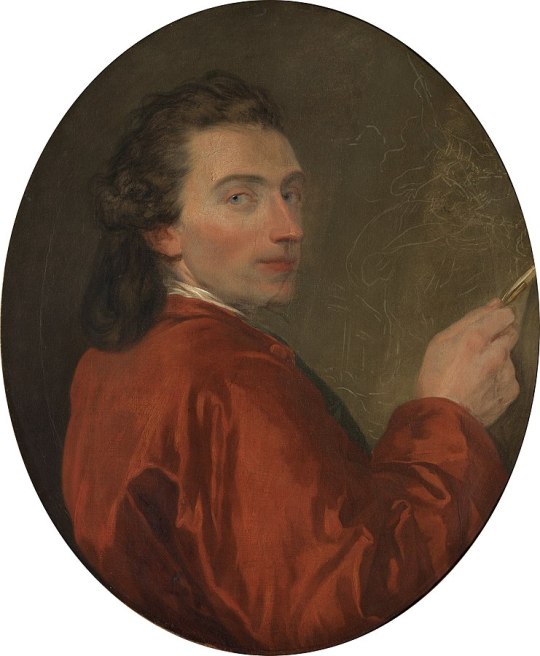
Joseph-Benoît Suvée - selfportrait - 1771
Joseph-Benoît Suvée (3 January 1743 – 9 February 1807) was a Flemish painter strongly influenced by French neo-classicism.
Suvée was born in Bruges. Initially a pupil of Matthias de Visch, he came to France aged 19 and became a pupil of Jean-Jacques Bachelier. In 1771, he won the Prix de Rome. In Rome from 1772 to 1778, he prolonged the usual duration allowed to pensionaries of the French Academy in Rome. He was named an academician on his return to Paris and he opened an art school for young women at the Louvre. One of his students was Constance Mayer. He emulated and competed with Jacques-Louis David, earning his enduring hatred.
Named the French Academy in Rome's director in 1792, replacing François-Guillaume Ménageot, he was imprisoned for a while in the Prison Saint-Lazare and only able to take up the post in 1801. After a brilliant career, and a six years' stay in Rome as the Academy's Director, he died there suddenly.
His works include Achilles depositing the body of Hector at the feet of the body of Patroclus, (1769, Louvre), and Cornelia, mother of the Gracchi, (1795, Louvre).
His pupils were Jean-Baptiste Joseph Autrique (1777–1853), Augustin van den Berghe, Marie Bouliard, Cornelis Cels, Césarine Henriette Flore Davin, Joseph-François Ducq, Jean-Bernard Duvivier, Guillielmus Petrus Geysen (1761–1827), Albert Gregorius, Jean-François Legillon, Constance Mayer, Jozef Karel De Meulemeester (1774–1836), Joseph Denis Odevaere, Gertrude de Pélichy, Pierre Joseph Petit (1768–1825), Ange René Ravault (1766–1845), Jacques-Albert Senave, Charles Spruyt (1769–1851), Philip van der Wal (1774–?), and François Wynckelman . Anna Barbara Bansi, with whom he is said to have had an affair, was another pupil.
14 notes
·
View notes
Text






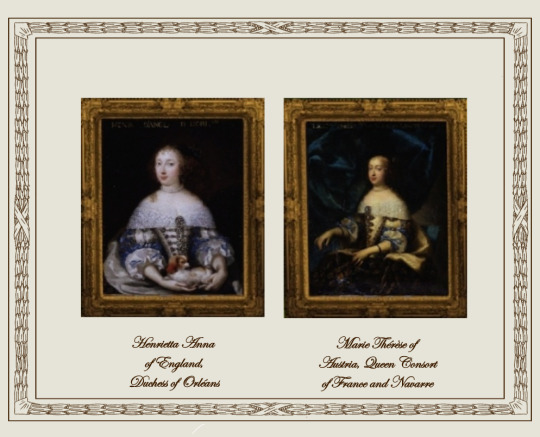
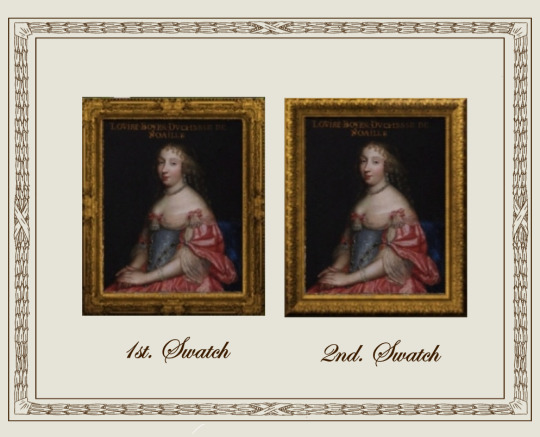
Louis XIV's Gallery of Beauties
A retexture by La Comtesse Zouboff — Original Mesh by @thejim07
This set of 20 portraits was comissioned by the king himself in the 1650s to Charles and Henri Beaubrun (except for a portrait of Henrietta Anna of England, Comissioned to Nicolas Mignard) The portraits comprises the queen, royal princesses and ladies of the court. They hanged at the king's appartments at Versailles. In the 1670s the paintings were progressively relegated to the king's minor residences, but in 1837, Louis-Philippe, King of the French turned Versailles into a museum and rejoined the paintings, in the Louis XIV Rooms, where they remain.
The set includes 20 portraits, with the original frame swatches, fully recolorable. The portraits are of:
Anne Genèvieve de Bourbon, Duchess d'Estouteville and Longueville
Françoise-Athénaïs de Rochechouart (later, Marquise de Montespan)
Anna Martonozzi, Princess of Conti
Anne Louise Boyer, Duchess of Noailles
Anne Marie Gonzaga, Countess Palatine
Anne de Rohan-Chabot, Princess de Soubise
Catherine Henriette d'Harcourt, Duchess d'Arpajon
Catherine de Neuville, Countess d'Armagnac
Charlotte Catherine de Gramont, Proncess of Monaco
Charlotte Isabelle Angélique de Montmorency-Bouteville, Duchess of Mecklenburg-Schwerin
Elizabeth of Orléans, Duchess of Guise and Joÿeuse
Françoise Madeleine d'Orléans (née de Valois) Duchess of Savoy
Françoise Mignot, Mareschalle of l'Hospital
Françoise de Neufville, Duchess of Chaulnes
Gabrielle-Louise de Saint-Simon, Duchess of Brissac
Henrietta Anna of England, Duchess of Orléans
Madeleine-Charlotte d'Albert-d'Ailly, Duchess of Foix
Marguerite Louise d'Orléans, Grand Duchess of Tuscany
Marguerite-Louise-Suzanne de Béthune-Sully, Countess of Gyche
Marie Thérèse of Austria, Queen Consort of France and Navarre
Found under Decor > Paintings for 940 §
Retextured from the "portrait of Anne Marie Louise d'Orléans", found here
Table, torcheres and floor by @thejim07
Rest of the decor by @joojconverts

Drive
(Sims3pack | package)
(Useful tags)
@joojconverts @ts3history @ts3historicalccfinds @deniisu-sims @katsujiiccfinds
-------------------------------------------------------
#the sims 3#ts3#sims 3 cc#portrait#s3cc#sims 3#sims 3 download#sims 3 cc finds#palace of versailles#sims 3 decor#wall decor
43 notes
·
View notes
Text

Henriette:
She was the sister of Louis XIII and the wife of Charles Ist of England. The Maryland is named after her. Her dad died when she was a month old. The Duke of Buckingham was literally trying to seduce her sister-in-law (Anne d'Autriche) and prevent Charles Ist from sleeping with his own wife, which is a lot for one man.
Marie-Thérèse:
First child of Louis XVI and Marie-Antoinette, and the only member of her family to survive the French Revolution, she was left completely alone in her cell as her family was killed or died of mistreatments one after the other. Despite the salic law she was for a while considered an heir presumptive to the throne by royalists as she was, despite her young age, known for her strong morals and her strong will, and so probably a better candidate than the future Louis XVIII. She leaves for Vienna as soon as she is allowed to leave her cell and goes to live at the austrian court.
Dates indicated are dates of life.
4 notes
·
View notes
Video
youtube
Henrietta Maria with Elena Maria Vidal - Plotlines
0 notes
Text
Some post Louis XIV fashion -
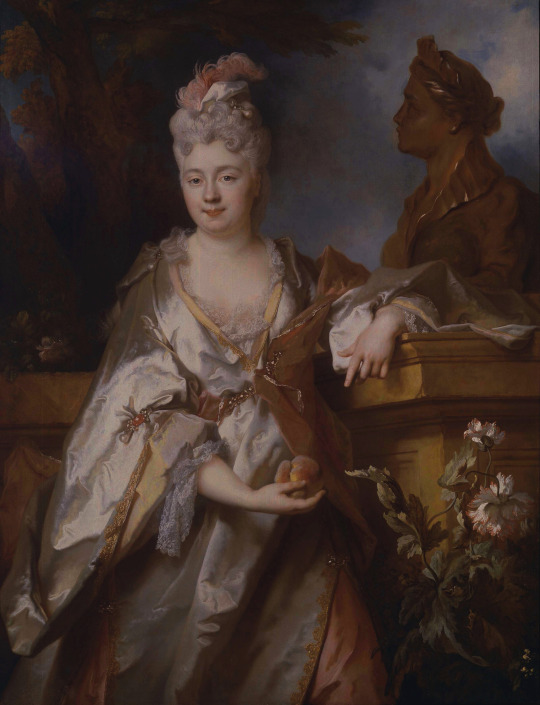
1715 Jeanne-Cecil Le Guay de Montgermon, three quarter length in a white satin robe with gold trimming and a ruby and pearl brooch by Nicolas de Largillière (Robilant & Voena, specific location ?). From their Web site; From their Web site; fixed spots in background with Photoshop and increased color saturation. 2721X3532.

1716 Mary Josephine Drummond, condesa de Castelblanco by Jean Baptiste Oudry (Museo del Prado - Madrid, Spain). From their Web site;fixed spots w Pshop 2045X2717.

ca. 1715 Louise Adélaïde de Bourbon by Pierre Gobert (Châteaux de Versailles et de Trianon - Versailles, Île-de-France, France) photo - Gérard Blot. From Réunion des Musées nationaux; enlarged by half 726X956.

ca. 1715 Sarah Lascelles (1656/1659–1743), Mrs Joshua Iremonger II, then Mrs Christopher Lethieullier by Michael Dahl I (Uppark House and Garden - South Harting, Petersfield, West Sussex, UK). From bbc.co (now artuk.org) 652X800.
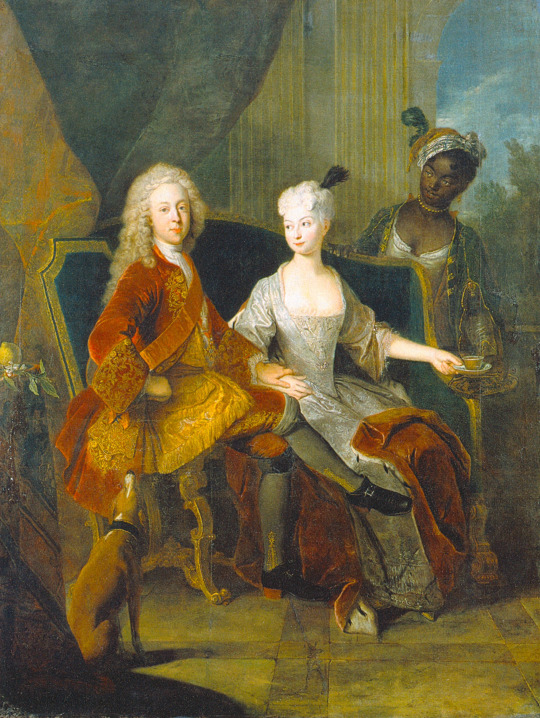
ca. 1716 Friedrich Ludwig of Württemberg and his wife Henriette Marie of Brandenburg-Schwedt by Antoine Pesne (Staatliches Museum Schwerin - Schwerin, Mecklenburg-Vorpommern, Germany). From Wikimedia; removed spots and linear and splotch flaws with. Photoshop 2078X2763.
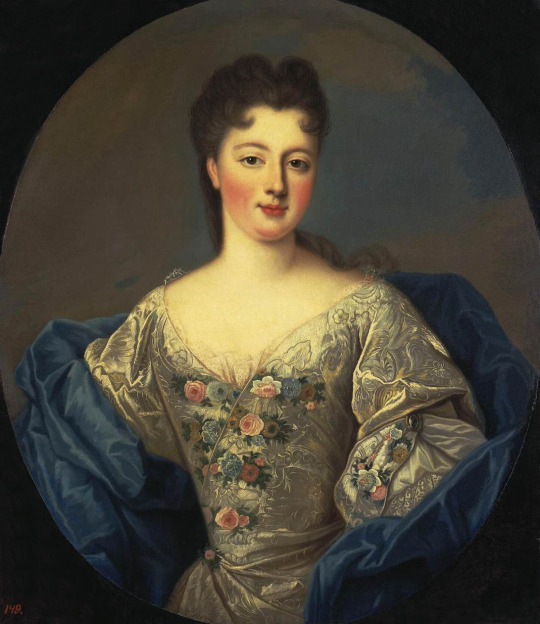
ca. 1716 Marie Louise Adélaïde d'Orléans the future Abbess of Chelles, daughter of the Regent of France by Pierre Gobert (Domaine de Sceaux - Sceaux, Hauts-de-Seine, Île-de-France, France). From Wikimedia; fixed spots w Pshop 1069X1235.

ca. 1717 Madame de Ventadour by Pierre Mignard (Châteaux de Versailles et de Trianon - Versailles, Île-de-France, France). From Wikimedia 1516X2000.The abundant lace ruffles on her sleeves point to the future while the headdress looks back to Fontanges and cleft coiffures.

Lady, said to be Marie-Elisabeth Le Fèvre de Caumartin (d. 1717) by Nicolas de Largillière (Sotheby's - 13Jun07 auction Lot 56). From their Web site; fixed obvious spots & cracks w Pshop 2396X2866.
#1710s fashion#late Baroque fashion#Rococo fashion#Georgian fashion#Louis XV fashion#Nicolas de Largillière#Jean Baptiste Oudry#Michael Dahl#Antoine Pesne#Pierre Gobert#Pierre Mignard
6 notes
·
View notes
Text
youtube
Georges Bizet - Ivan IV, WD 12, Act I, Scene 1: Puisons, mes sœurs - Puisses-tu voir longtemps encore (Marie, Le jeune Bulgare, Chœur de femmes) ·
Luc Héry · Inva Mula ·
Orchestre national de France · Michaël Schønwandt ·
Henriette Bonde-Hansen · Chœur de radio France · · Francois-Hippolyte Leroy · Henri Trianon
2 notes
·
View notes
Text
Pauline Auzou (24 March 1775 – 15 May 1835) was a French painter and art instructor, who exhibited at the Paris Salon and was commissioned to make paintings of Napoleon and his wife Marie Louise, Duchess of Parma.
In the early late 18th century women were generally prevented from attaining an education in art academies in France, particularly if they did not have money and connections. Auzou attended Jean-Baptiste Regnault's atelier in 1802 along with Sophie Guillemard, Eugénie Delaporte , Caroline Derigny and Henriette Lorimier. She was influenced by another woman artist, Marguerite Gérard, and by Jean-Auguste-Dominique Ingres.
Early in her studies and career, Auzou made paintings of legendary Greek figures. Very unusual for the time, when it was considered nearly underheard of for women to draw or paint nude people, Auzou made studies of nude women and men. Deemed inappropriate, women artists found greater success in creating paintings of women in homey settings, making music or reading.
She was a successful artist, first a Neoclassist, who made historic, genre and portrait paintings, including depictions of Napoleon. She received 2,000 to 4,000 francs in stipend payments, for the creation of essentially government mandated paintings of contemporary events, including paintings made of and for Napoleon. Troubadour art, was very much a style made by male artists, but there were several artists like Eugénie Servières, Hortense Haudebourt-Lescot, and Sophie Lemire who added a feminine touch to makes of Caroline, Duchesse de Berry and Empress Josephine and others.
The Paris Salon opened up the exhibition to women's works in 1791. Her works were exhibited at the Paris Salon. In 1793, A Bacchante and A study of a head. She made a painting of legendary Daphnis and Phyllis, which was exhibited at the 1795 salon. In 1804, The First Sense of Coquetry was exhibited there. She was awarded a first class medal at the salon in 1806 for her painting of Pickard Elder, which in 1807 was represented in the painting Mr. Pickard and his family. In 1808, she was awarded the medaille de première classe for her work. That year she exhibited Mr. Picard and his family at the salon.
She made a painting of Napoleon and his bride shown at the 1810 salon entitled Archduchess Marie-Louise in Compiègne, depicts the newly married Napoleon who looks on fondly, and secondarily, as Marie-Louise is met by her ladys-in-waiting. Other paintings made of the couple by Auzou included a painting of Marie-Louise with her family, Her Majesty the Empress, before Her Marriage, at the Moment of Taking Leave of Her Family. Shown in 1806, Departure for the Duel depicts the family drama as a man looks at his sleeping wife and child before departing for a duel. Like other women artists of this time, Auzou depicted events as they impacted families. In this case, the wife was "condemned to seduction and the child to poverty," according to art critic Pierre-Jean-Baptiste Chaussard. She exhibited at the Paris Salon until 1817 and generally until 1820.
Auzou opened an art school for young women, like other women artists, Lizinka de Mirbel and Marie Guilhelmine Benoist, and men. The studio and school were maintained for 20 years. Her book Têtes d'études (English: Head studies) was published in Paris by Didot.
Her painting Portrait of a musician is in the collection of the Currier Museum of Art, Manchester, New Hampshire, United States. Two of her works of Empress Marie-Louise are in the collections of The National Museum of Versailles, Palace of Versailles, including Her Majesty the Empress, before Her Marriage, at the Moment of Taking Leave of Her Family. Her works were collected by the Society of Friends to the Arts, Duchess de Berri and the French government. Several of these works were engraved, as well as period genre paintings such as the work engraved by John Norman, Diana of France and Montmorency.

The piano lesson by Pauline Auzou, c. 1796
255 notes
·
View notes
Text
Jong van Beek en Donk Cécile de - L'inévitable Réparation (Hilda van Suylenburg)
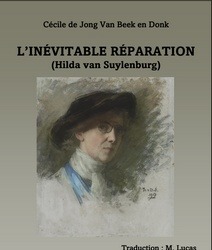
Jong van Beek en Donk Cécile de - L'inévitable Réparation (Hilda van Suylenburg): Après Un Mariage scandaleux publié en début de semaine, voici un autre écrit féministe du tournant du siècle. Ce roman, qui met en avant des idées féministes, a connu un grand succès et a fait l’objet de beaucoup de discussions à sa parution. Dans de courts chapitres, nous voyons les héroïnes de bonne famille et leurs quelques supporters masculins lutter contre les préjugés limitant les droits des femmes et défendre plus largement les causes sociales, revendiquant notamment l’égalité des salaires pour introduire plus de justice dans le monde du travail et éviter les discriminations. Cécile de Jong van Beek en Donk est née à Alkmaar le 19 mai 1866. Son père, procureur général à Den Bosch, avait pris avant sa nomination de nombreuses initiatives de lutte contre la pauvreté et sa mère avait milité pour le droit au travail rémunéré des femmes des classes bourgeoises. Cécile passe un certificat d’éducation secondaire puis épouse un riche propriétaire terrien dépressif dont elle se sépare. Déçue et seule mais fortunée, elle milite pour la défense des animaux puis au cours d'un voyage à travers l'Amérique où elle observe une plus grande liberté des femmes, elle visite le Women’s Building de l'Exposition universelle de Chicago. De retour aux Pays-Bas, elle se consacre à la création d'une exposition similaire à La Haye et à l'écriture d'un roman pour promouvoir l'émancipation des femmes. Lorsque, à l'été 1898, a lieu l'exposition nationale pour le travail des femmes, elle attire près de cent mille visiteurs dont beaucoup avaient déjà lu le roman que nous vous présentons ici Hilda van Suylenburg écrit en hollandais l’année précédente. Ce grand succès est tempéré par un accueil mitigé du parti travailliste social-démocrate (SDAP) et d’autres féministes. Ces dames « conviennent à votre sujet, pour vous et sans vous », écrit Henriette Roland Holst-van der Scha dans sa critique féroce Un mot aux femmes de la classe ouvrière à l'occasion de l'Exposition nationale du travail des femmes. Néanmoins, cet ouvrage, aisé à lire et intéressant à plus d'un titre, fut le roman hollandais le plus lu et le plus discuté de la fin du 19e siècle. Installée en France avec son second mari, Cécile se convertit au catholicisme et renie certains de ses livres féministes. La première guerre mondiale exacerbe en elle un nationalisme qui devient plus français que les français. Dans l��entre deux guerre le couple évolue vers un nationalisme maurassien . Elle décède à Méréville le 15 juin 1944. Téléchargements : ePUB - PDF - PDF (Petits Écrans) - Kindle-MOBI - HTML - DOC/ODT Read the full article
0 notes